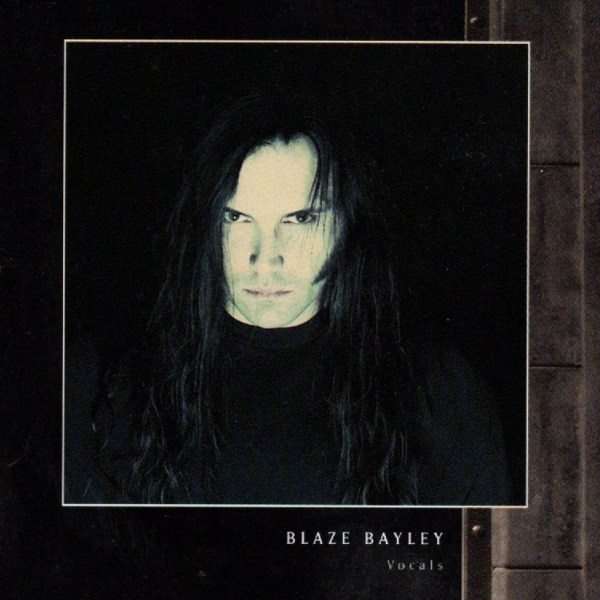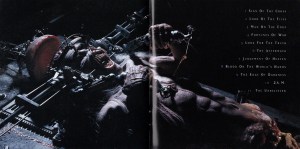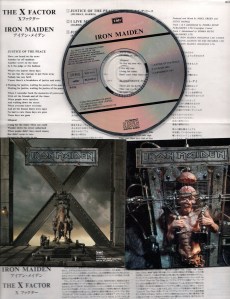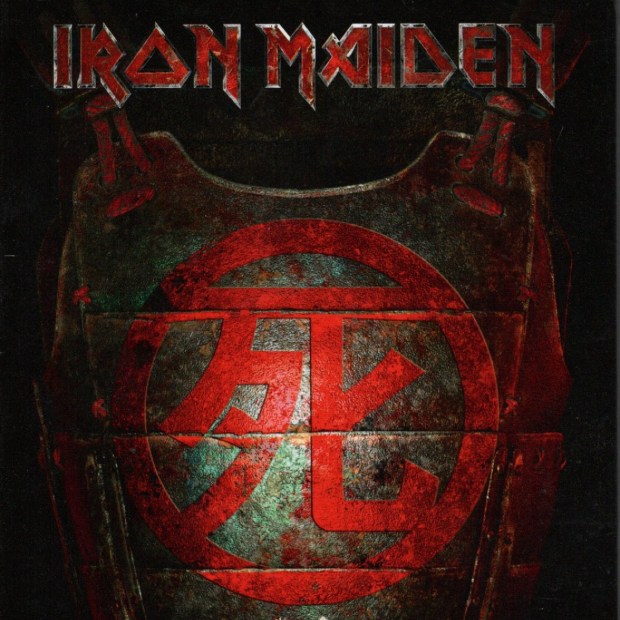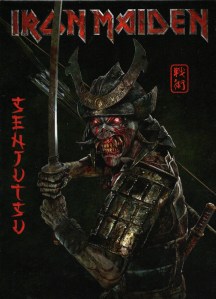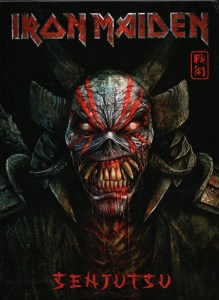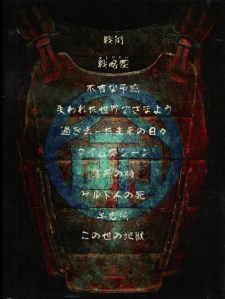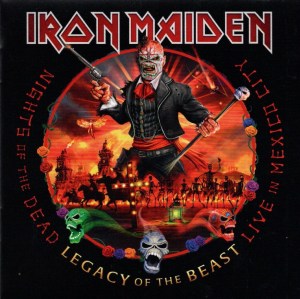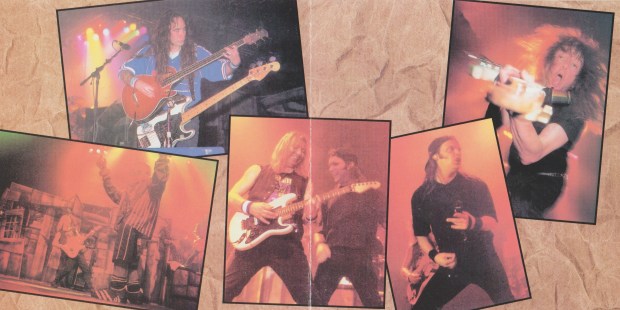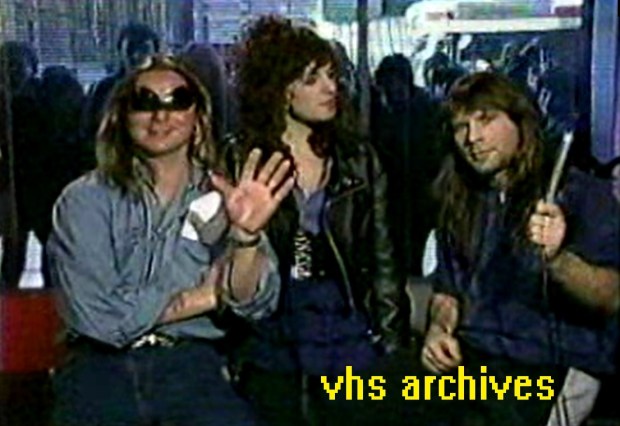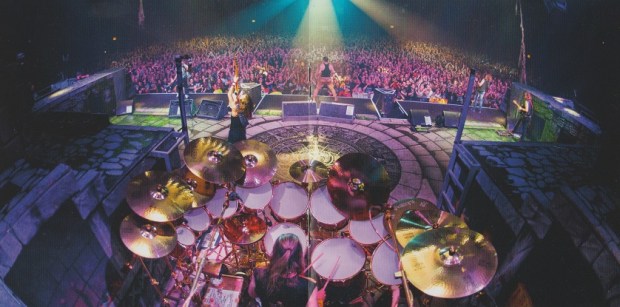 IRON MAIDEN – The X Factor (1995 EMI Japan 2 CD limited edition)
IRON MAIDEN – The X Factor (1995 EMI Japan 2 CD limited edition)
For this revisit, we will take a deep dive on the Japanese version of Iron Maiden’s controversial 1995 album The X Factor. As the first new studio album in three years, anticipation ran high. There was also a minor problem that needed sorting out. Longtime vocalist Bruce Dickinson quit to go solo after more than a decade in Iron Maiden, leaving the remaining band with an air raid siren-sized hole to fill. The band had already been rocked by the 1990 departure of guitarist Adrian Smith, whose songwriting and melodic solo construction was missed. That’s not a knock on the guy who replaced him, Janick Gers. Gers was a different kind of player, and the elements that Smith used to bring to the band were gone. Fans had to endure an even more serious change when Wolfsbane vocalist Blaze Bayley was chosen to replace Bruce.
Virtually unknown in North America, Blaze Bayley was a powerhouse baritone who wasn’t known for hitting the highs of Bruce Dickinson. However, Maiden seemed to like change and the 1990s were a darker time. In that context, Bayley was a better fit. Bruce’s style of singing was on its way out, while Bayley could have fronted a grunge band had he chosen to go that way. At the same time, Steve Harris was dealing with losses in his life, and Bayley’s voice suited the more pensive tone of the new music. In another major change, producer Martin Birch stepped down leaving Steve Harris and co-producer Nigel Green to their own devices, for better or for worse. You’ll notice the mix is quite bass-heavy….
The X Factor was released in October of 1995 to a lot of indifference. Even the new cover art by Hugh Syme turned off some fans. It was the longest Maiden album so far by a long shot at over 70 minutes. In Japan, the CD came with a bonus disc of three original B-sides, boosting the length to over 82 minutes. Maiden rarely recorded original material for B-sides (“Total Eclipse” notwithstanding), but this time they had 14 tracks to choose from in total. A bumper crop of creativity.
“Sign of the Cross” has to be one of Maiden’s most impactful openers, though it takes a minute to get going. If you thought you bought a CD of Gregorian chants (very big in 1995; even Van Halen used ’em), then that’s forgivable. Maiden jumped on the chant bandwagon for the 11 minute epic opener, a very unique track in the catalogue. A bass intro begins the song proper, and if there’s one flaw on The X Factor, it’s too many bass intros (see above comment about “left to their own devices”). The clean guitars backing the bass are a nice touch, and there is no question that The X Factor is a brilliant sounding album. The vocals finally kick in almost three minutes into the song, kicking the song into a slow determined march. The evocative imagery recalls dark corners of Catholic history while the music goes through multiple thrilling sections, from speedy manic solos (Janick proving his worth to a song like that) to more complex rhythms. The song eventually resolves as it began, in quiet contemplation accompanied by bass. “Sign of the Cross” was considered good enough to keep in the set even after Dickinson returned to Iron Maiden at the end of the 90s.
 Wisely picking up the pace for the next track, the single “Lord of the Flies” kicks it into higher gear. The speedy riff rocker barrels along steadily, with a slamming chorus. Co-written by Gers, you can hear his influence. Blaze sinks his teeth into the meaty verses and the chorus delivers the kind of hooks that we’re used to from Iron Maiden. Once again, Bruce sang this song when he returned. In this case, Dickinson was able to elevate the tune by using his air raid siren to boost the chorus. That’s not a knock on Blaze, who owns the tune with grit and bite.
Wisely picking up the pace for the next track, the single “Lord of the Flies” kicks it into higher gear. The speedy riff rocker barrels along steadily, with a slamming chorus. Co-written by Gers, you can hear his influence. Blaze sinks his teeth into the meaty verses and the chorus delivers the kind of hooks that we’re used to from Iron Maiden. Once again, Bruce sang this song when he returned. In this case, Dickinson was able to elevate the tune by using his air raid siren to boost the chorus. That’s not a knock on Blaze, who owns the tune with grit and bite.
 “Man on the Edge” is an interesting song not because it was the poorly chosen first single. It’s interesting because just six years earlier, the song could never have been written. As a co-write between Gers and Bayley, it’s entirely composed by the newest members. Based on the excellent film Falling Down, the song depicts the character of “D-Fens” gradually losing it over the course of a day. It’s just not up to the quality of the prior two songs, but Bruce still performed it on the 1999 tour. Be forewarned: excluding the bonus disc, this is pretty much the last time Iron Maiden pick up the pace on The X Factor.
“Man on the Edge” is an interesting song not because it was the poorly chosen first single. It’s interesting because just six years earlier, the song could never have been written. As a co-write between Gers and Bayley, it’s entirely composed by the newest members. Based on the excellent film Falling Down, the song depicts the character of “D-Fens” gradually losing it over the course of a day. It’s just not up to the quality of the prior two songs, but Bruce still performed it on the 1999 tour. Be forewarned: excluding the bonus disc, this is pretty much the last time Iron Maiden pick up the pace on The X Factor.
That’s not to say the rest of the songs are junk. “Fortunes of War” (another bass intro) begins soft and ballady, although it does get moving towards the end. In the 1990s, Steve Harris really leaned into repeating sections of his songs, and “Fortunes of War” is certainly one of those. It’s also one of many tunes on the album based on, or including, war imagery. There’s a neat guitar part stuffed between bass sections, but too many bass sections! It’s not that interesting an instrument, Steve. Janick Gers and Dave Murray lay down a pair of nice solos, and drummer Nicko McBrain plays it fairly straight. Not a lot of elaborate drum rolls on this album. Nicko lays back with the songs.
The last song on side one was “Look For the Truth”, a dark contemplative song about personal struggles. The bass intro this time is at least accompanied by guitar. “Look For the Truth” begins slowly but then slams into heavy. Blaze really has this one firmly in his grasp, as he spits out the words. “It’s my final stand, I make a fist out of each hand. To the shadows of the past, take a breath and I scream attack.” This is the first of four co-writes between Harris, Gers and Bayley. (Gers has seven credits on the first disc, Bayley has five, and Harris ten.) The main hook here is a simple “Woah oh oh,” which works fine and dandy, and did so in concert.
“The Aftermath” is another slow war song…but with no bass intro! It’s a little unorthodox as it goes almost three minutes before we hit the first chorus. It really takes a while to get to the point where they speed it up, but it finally does with a cry of “I’m just a soldier!” and another wicked Janick Gers solo. Then it resumes its plodding pace to the close. Not an album highlight, but a song that was performed live on The X Fac-tour.
A little peppier is “Judgement of Heaven”, another soul-searching number with lines like “I’ve been depressed so long, it’s hard to remember being happy,” and “I felt like suicide, a dozen times or more.” That’s countered with the line, “But that’s the easy way, that’s the selfish way, the hardest part is to get on with your life.” Then the music cranks into gear and you feel empowered by the music and Blaze’s gravelly delivery. You got this — you can do whatever you need to. You can survive. That’s the message and it sounds great coming from Iron Maiden. The uplifting chorus “All of my life, I have believed judgement of Heaven is waiting for me,” is a little Christian sounding for this band, but it does the job. And Davey Murray then flies in with a wicked signature solo, and then Gers joins in for some harmonies. Blaze even tries for a high note at the end!
The album dips a bit in quality at this point. “Blood on the World’s Hands” is not of the finest moments on The X Factor. It boasts the worst bass intro yet, and it goes on for-bloody-ever. At some points it sounds as bad I do, just randomly hitting notes in random order. Mercifully the song really begins at 1:15 but the damage has been done. It’s a decent song from that point on…but see above about Steve being left to his own devices as co-producer with Nigel Green. A different producer would have axed that intro. Cool Murray/Gers solo though, and Nicko gets to play around with unorthodox drums patterns.
“The Edge of Darkness” feels as if we’re moving towards an ending. A dramatic re-telling of Apocalypse Now with yet another bass intro, this is a good song. How many war songs do you need? Don’t worry, this is the last one. Like most of the tunes (especially those with bass intros), it begins slowly before heavy-ing up partway. When it gets galloping, it’s solid gold. “I know Captain that you’ve done this work before, we’ve got a problem and you can help us I am sure.” You know where it goes from there. “Your mission, terminate with extreme prejudice.” All he wanted was a mission and for his sins they gave him one. Vocally, Blaze has his hands full here with rapid-fire lyrics and plenty of “Woah-oh” hooks. The guitar solos are like old-school Maiden again, and the gallop recalls earlier days. “And now I understand why the genius must die…”
The album goes dark with “2 A.M.”, the third of the contemplative songs of self-reflection. On first listen it doesn’t stand out but it grows over time. “Here I am again, on my own again…” We’ve all felt that way. This is a sparse, direct, morose tune but not without merit. On past albums it probably would not have made the final cut, though the guitar sections are great.
The final track on disc one is “The Unbeliever”, another unorthodox tune, centered on a bassline, but at least without a bass intro! A Gers/Harris composition of self-reflection, that has a very different rhythm and layering of instruments. “All my life, I’ve run astray, allowed my faith to drift away.” Interesting that there are so many songs on this album about losing faith: “Sign of the Cross”, “Judgement of Heaven”, and “The Unbeliever”. The three dominant themes on this album (often overlapping) are war, losing faith, and personal struggles. Quite different from the Iron Maiden that wrote songs about mythology, killers in alleyways, and dying with your boots on. If there was ever a time to turn inwards and reflect, it was the 1990s. Later albums would find a stronger balance of lyrical themes, but there is no question that the music of The X Factor suits the lyrics perfectly and vice-versa.
“The Unbeliever” ends with just an audio snip of studio chatter. “That’s the one!” somebody says after a good take.
Over to disc two, exclusive to Japan: all three tracks were available on B-sides to “Man on the Edge”, but one was exclusive to vinyl. All three are fast songs that would have dramatically altered the complexion of the album had they been included in the regular tracklist.
The only Dave Murray co-write (with Harris) is the speedy “Justice of the Peace”. This tune is about the decline of modern society. “It must be the cynic in me, but I don’t really like things now. The violence, the attitude, aggression that you see every day. Sick society looks the other way.” It has a similar vibe to “Man on the Edge” though not as manically paced. Murray lays down a classic Beast-era sounding solo to top it off. It’s over and out in just 3:34, the shortest song of them all.
“I Live My Way” is special because this is its only release on CD. The only other way to get it is on vinyl. Most Iron Maiden fans simply do not own a copy. As another speedy tune written by Harris/Gers/Bayley, it’s probably the least remarkable but certainly a special rarity. You can count this as another one about self-reflection, though more headstrong and confident.
“Judgement Day”, the second song written by Blaze and Janick without involvement from Steve, is a fast blazer continuing the critique on modern society. When the bonus tracks are considered, commentary on humanity could be considered the fourth dominant theme. “There are no marks upon a man, that can say he’s good or bad.” The lens is focused this time on the evil people living among us. Musically it is most similar to a previous Maiden single called “Be Quick or Be Dead”.
The X Factor is a long album to start with, but the bonus disc here adds incredible value not only for the collector, but also for the listening experience. The album needed more pep, less slow songs and fewer bass intros. You could make a pretty incredible vintage-sounding X Factor “greatest hits” CD by including some of these B-sides, and capping the run time off at 45 minutes.
Japanese releases often got bonuses but this one has more than just extra music. The old style “fat” CD case conceals additional booklets, some not included in the international releases; four in total. They include:
- Japanese lyric sheet for the album.
- Japanese lyric sheet for the bonus disc.
- Regular CD booklet, same as the international release.
- Bonus 22 page full colour booklet exclusive to this release.
This bonus booklet is a real treat, featuring tons of album and single art, with band photos. It includes a discography and list of Japanese tours, including the setlists. It’s great even if you can’t read the notes in Japanese; all the titles are in English.
The X Factor is a deeply personal album that Steve Harris is very proud of and considers one of his best. Fans have been split on this, with most considering it inferior to almost all the prior albums. That’s not fair. It’s very different, less aggressive, darker and slower. It was an experimental evolution made possible by lineup changes and the shifting sands of the musical tastes of the 1990s. There are deeper songs and the material fit the downbeat mood of the time. Many of the songs were more energetic live. Overall, not one of Maiden’s top five, and not a commercial success, but it can be a rewarding if overly long listen. The inclusion of the B-sides on the Japanese set dramatically improves the experience.
3.75/5 stars

